AG #45 1890 Whitbread X Ale
-
BrewerBen
AG #45 1890 Whitbread X Ale
I thought i'd have a go at the recipe for "1890 Whitbread X Ale" from Ron Pattinson's The Homebrewer's Guide to Vintage Beer.
There are a few reasons i chose this beer, the main one is the grain bill can fit in my braumeister and being impatient hopefully it wont need a long maturation time. I also found it quite interesting that hops from the US and Germany were used in 1880. .
The Recipe calls for:
4800g Mild Malt
680g Pale Malt
907g No.2 Invert Sugar
90 Min Cluster 28g
60 Min Fuggle 57g
30 Min Spalter 35g
I've had to do a couple of substitutions as i could not find anyone selling Spalter hops so i'll be using Spalt Select instead. I've also only just realised i don't have enough Fuggle so i'll use 25g of Fuggle and 32g of Golding.
The Invert sugar was another substitution as i didn't want to make my own but still wanted to use something close. While searching for idea's i came across this: http://www.unholymess.com/blog/beer-bre ... ers-invert which at the bottom suggest mixing Golden syrup and blackstrap (i'm assuming thats the US version of treacle). According to the handy calculater 896g of Golden syrup and 11g of treacle should get me something similar to no. 2 Invert.
I'll be using dry yeast and so the natural choice would be S-04 as i have seen it mentioned on occasion that its a dried version of a Whitbread yeast.
The book lists the mash schedule as:
Mash 1 (64.4C) 10.4L
Underlet (65.6C) 3.8L
Mash 2 (68.9C) 5.7L
Sparge (73.9C) 1.5L
As i'm using the Braumeister multi step mashes are what it does best, and has some similarities to the underlet method as the wort is
pumped from underneath the malt pipe (ok that similarity may be a bit tenuous but it makes me feel better as i'm trying to recreate a historic brew).
The schedule i've come up with is as follows:
Step 1: 64C 60Mins - 30L Water
Step 2: 69C 30Mins
Step 3: 74C 10Mins
Sparge: 74C (Optional with the braumesiter but i always like to do it) - 8L Water
The underlet i figure will be the rise time between step 1 and step 2.
With a 90 Minute boil that should give me 25L of wort at 1.062 (including the sugar).
The book has the pitching temp of 15.6C. This seems pretty cool for a ale but is within the ideal temp range of 15-20 that fermentis lists for S-04. Unfortunately i can't do temperature controlled fermentation but with the cold weather i would normally struggle to keep it at the usual 18-20 anyway.
I'll probably follow my usual procedure from this point of ferment for 10-14 days and then bottle straight from primary as I don't really have the space for a long secondary that was probably the norm for this beer. I also may dry hop with a mix of spalt select and/or golding.
There are a few reasons i chose this beer, the main one is the grain bill can fit in my braumeister and being impatient hopefully it wont need a long maturation time. I also found it quite interesting that hops from the US and Germany were used in 1880. .
The Recipe calls for:
4800g Mild Malt
680g Pale Malt
907g No.2 Invert Sugar
90 Min Cluster 28g
60 Min Fuggle 57g
30 Min Spalter 35g
I've had to do a couple of substitutions as i could not find anyone selling Spalter hops so i'll be using Spalt Select instead. I've also only just realised i don't have enough Fuggle so i'll use 25g of Fuggle and 32g of Golding.
The Invert sugar was another substitution as i didn't want to make my own but still wanted to use something close. While searching for idea's i came across this: http://www.unholymess.com/blog/beer-bre ... ers-invert which at the bottom suggest mixing Golden syrup and blackstrap (i'm assuming thats the US version of treacle). According to the handy calculater 896g of Golden syrup and 11g of treacle should get me something similar to no. 2 Invert.
I'll be using dry yeast and so the natural choice would be S-04 as i have seen it mentioned on occasion that its a dried version of a Whitbread yeast.
The book lists the mash schedule as:
Mash 1 (64.4C) 10.4L
Underlet (65.6C) 3.8L
Mash 2 (68.9C) 5.7L
Sparge (73.9C) 1.5L
As i'm using the Braumeister multi step mashes are what it does best, and has some similarities to the underlet method as the wort is
pumped from underneath the malt pipe (ok that similarity may be a bit tenuous but it makes me feel better as i'm trying to recreate a historic brew).
The schedule i've come up with is as follows:
Step 1: 64C 60Mins - 30L Water
Step 2: 69C 30Mins
Step 3: 74C 10Mins
Sparge: 74C (Optional with the braumesiter but i always like to do it) - 8L Water
The underlet i figure will be the rise time between step 1 and step 2.
With a 90 Minute boil that should give me 25L of wort at 1.062 (including the sugar).
The book has the pitching temp of 15.6C. This seems pretty cool for a ale but is within the ideal temp range of 15-20 that fermentis lists for S-04. Unfortunately i can't do temperature controlled fermentation but with the cold weather i would normally struggle to keep it at the usual 18-20 anyway.
I'll probably follow my usual procedure from this point of ferment for 10-14 days and then bottle straight from primary as I don't really have the space for a long secondary that was probably the norm for this beer. I also may dry hop with a mix of spalt select and/or golding.
-
BrewerBen
Re: AG #45 1890 Whitbread X Ale
I brewed this yesterday so here's how it went:
Mashed in and pumps on:
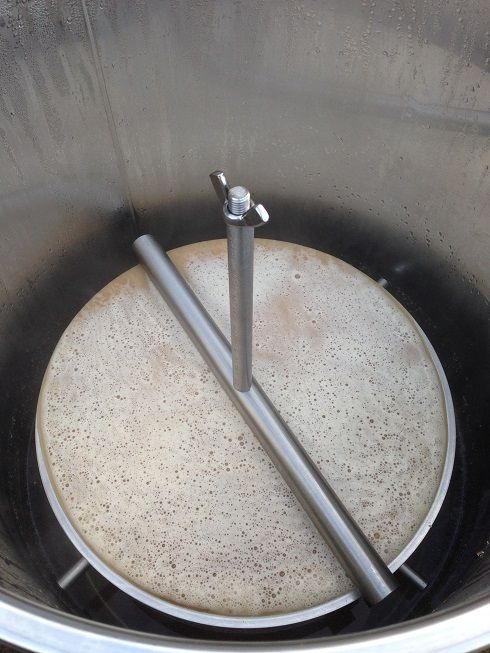
Golden Syrup:
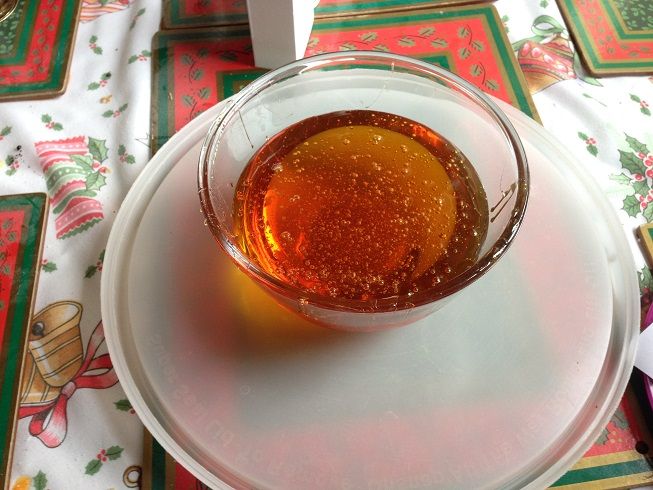
Golden syrup with 11g of treacle added. It made quite a difference to the colour:
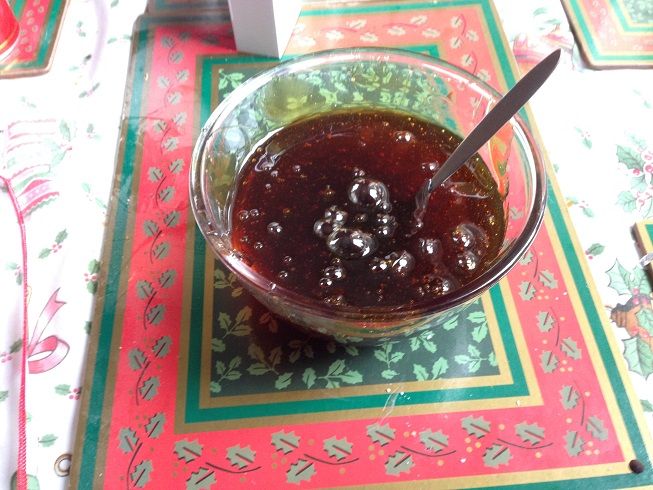
Hops measured out. These get put in hop bags before goin in the boil:
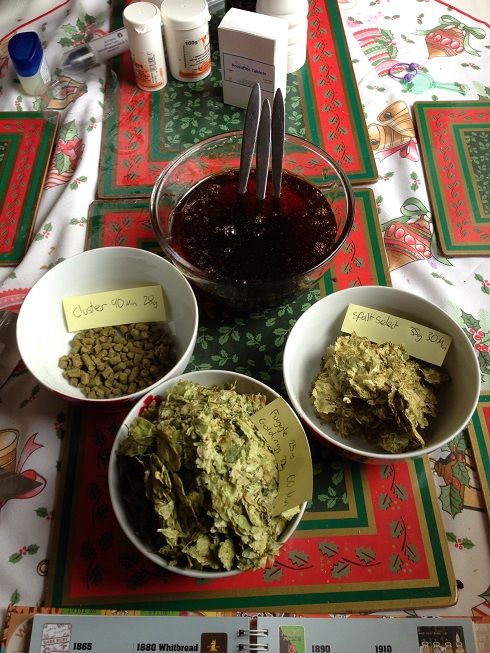
Mash almost done:
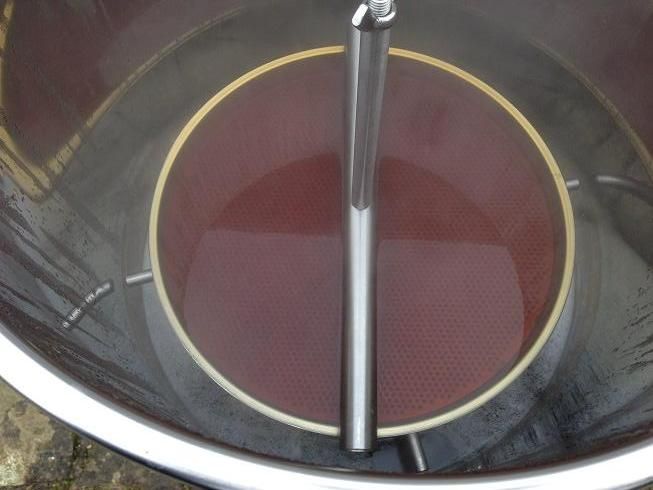
Spent grain left to drain after sparge to get any remaining wort:
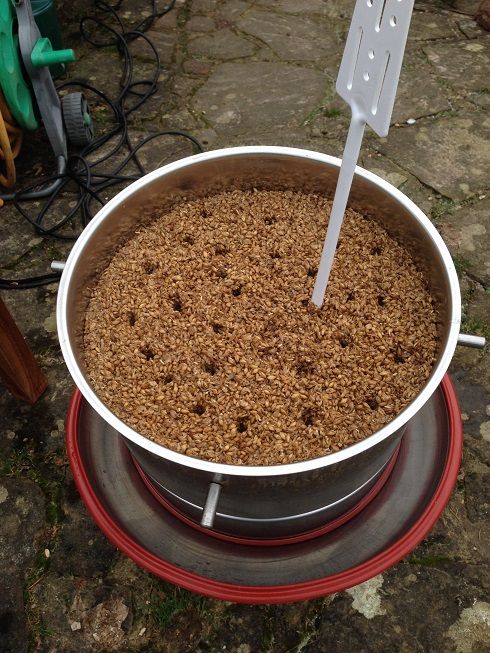
The sugar mixed with a little wort before adding to the boil. I want sure when to add the sugar so added with the 39 min hop addition:

Runoff into fermenter:
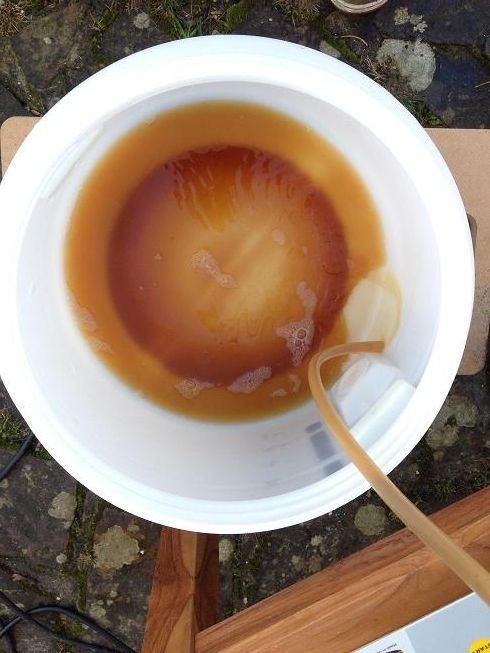
Re-hydrated S04 Yeast got nice and foamy. I used 16g of s04 as advised by the MrMalty yeast pitchiung calculatorL
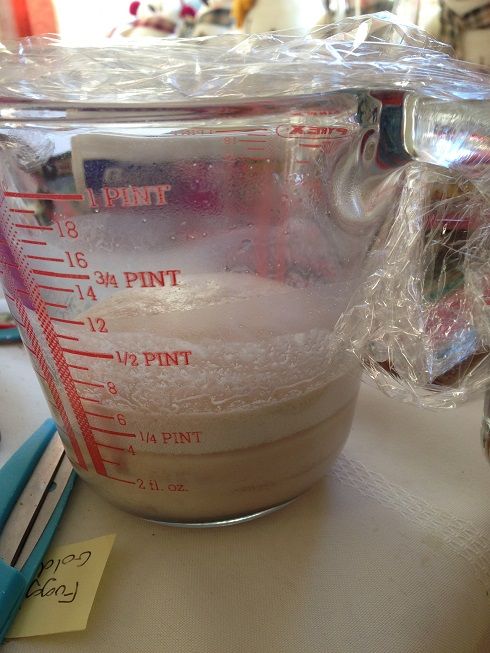
Gravity Reading:
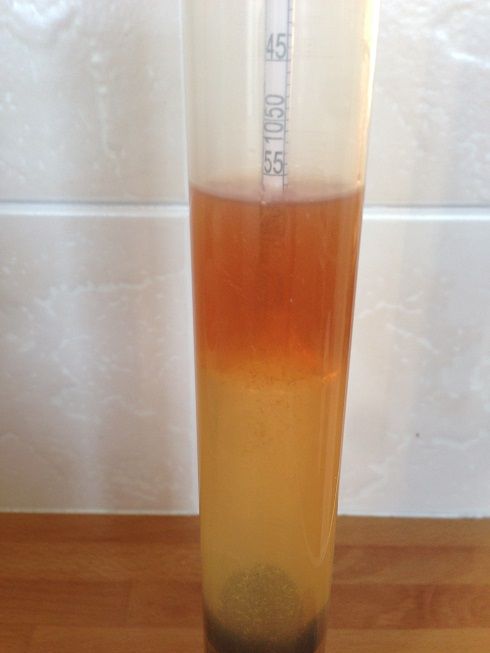
The brewday went nice and smoothly, the only hiccup was i missed the planned gravity as i was 2 Litres over on the volume so i ended up with 27 litres of 1.057 wort which puts my efficiency still at the 75% mark.
Mashed in and pumps on:

Golden Syrup:

Golden syrup with 11g of treacle added. It made quite a difference to the colour:

Hops measured out. These get put in hop bags before goin in the boil:

Mash almost done:

Spent grain left to drain after sparge to get any remaining wort:

The sugar mixed with a little wort before adding to the boil. I want sure when to add the sugar so added with the 39 min hop addition:

Runoff into fermenter:

Re-hydrated S04 Yeast got nice and foamy. I used 16g of s04 as advised by the MrMalty yeast pitchiung calculatorL

Gravity Reading:

The brewday went nice and smoothly, the only hiccup was i missed the planned gravity as i was 2 Litres over on the volume so i ended up with 27 litres of 1.057 wort which puts my efficiency still at the 75% mark.
-
paulg
Re: AG #45 1890 Whitbread X Ale
nice one ben
I will follow this with interest,please keep us updated on the outcome.
I to have an interest in trying to brew some old style recipes,I have just got the durden park book and was thinking of buying rons one too,as you have it what do you think of it are the recipes doable?.
i have seen many of his Lets Brew Wednesday recipes on his blog ,they all seem to call for the addition of caramel are these the same.
I too have a BM so would also go for a similar mash schedule
thanks in advance Paul
I will follow this with interest,please keep us updated on the outcome.
I to have an interest in trying to brew some old style recipes,I have just got the durden park book and was thinking of buying rons one too,as you have it what do you think of it are the recipes doable?.
i have seen many of his Lets Brew Wednesday recipes on his blog ,they all seem to call for the addition of caramel are these the same.
I too have a BM so would also go for a similar mash schedule
thanks in advance Paul
-
BrewerBen
Re: AG #45 1890 Whitbread X Ale
The book is a good buy. There is a good range of recipes in there, looking at the milds alone they range from 1832 with a gravity of 1.114 to 1950 and a gravity of 1.031.
The bigger beers will be more difficult on the BM but i do intend to try one at some point using the double mash technique I've seen mentioned. On the other hand there are not many beers in the book that don't have multiple mash temps so thats where the BM really comes into its own. Although there is a single infusion mash and sparge listed for the recipe the original mash schedule is still included.
Just having a flick through the book and i wouldn't say caramel is used in that many recipes and it only seems to have been used after 1900.
Porter there is 1 with caramel, Stout again only 1, In the IPA, Pale ale and Light Bitter sections none use caramel, Mild 5 recipes use caramel, Stock ale 6, Scottish Ale 2, Brown Ale all 4 recipes use caramel.
Something i found surprising, which was another reason for trying this beer was the large sugar additions, i spotted one recipe where it was 29%. I had thought that large sugar additions was more of a Belgian thing but apparently not.
On to the X Ale i'm brewing, fermentation has been vigorous and is already down to 1.018. Unfortunately the temp has risen more than i would like and is at 21C. Because of the break over christmas and the heating being on all day my usually cool spot for fermentation has got warmer than usual.
As these beers would normally end up in wood barrels i'm also tempted to get some oak chips to add at the same time as dry hopping.
The bigger beers will be more difficult on the BM but i do intend to try one at some point using the double mash technique I've seen mentioned. On the other hand there are not many beers in the book that don't have multiple mash temps so thats where the BM really comes into its own. Although there is a single infusion mash and sparge listed for the recipe the original mash schedule is still included.
Just having a flick through the book and i wouldn't say caramel is used in that many recipes and it only seems to have been used after 1900.
Porter there is 1 with caramel, Stout again only 1, In the IPA, Pale ale and Light Bitter sections none use caramel, Mild 5 recipes use caramel, Stock ale 6, Scottish Ale 2, Brown Ale all 4 recipes use caramel.
Something i found surprising, which was another reason for trying this beer was the large sugar additions, i spotted one recipe where it was 29%. I had thought that large sugar additions was more of a Belgian thing but apparently not.
On to the X Ale i'm brewing, fermentation has been vigorous and is already down to 1.018. Unfortunately the temp has risen more than i would like and is at 21C. Because of the break over christmas and the heating being on all day my usually cool spot for fermentation has got warmer than usual.
As these beers would normally end up in wood barrels i'm also tempted to get some oak chips to add at the same time as dry hopping.
-
paulg
Re: AG #45 1890 Whitbread X Ale
thanks for that ben.
the lets brew listing is here http://www.unholymess.com/blog/lets-brew/comment-page-1
as you will see quite a few specify caramel and 6 row pale malt .I assume the book doesnt .
Any way im convinced and will take a punt on it
the lets brew listing is here http://www.unholymess.com/blog/lets-brew/comment-page-1
as you will see quite a few specify caramel and 6 row pale malt .I assume the book doesnt .
Any way im convinced and will take a punt on it
-
BrewerBen
Re: AG #45 1890 Whitbread X Ale
In the book the 6 Row Pale malt is about as common as the caramel and again only seems to turn up in the 1900's, although i did notice Fullers seem to be a fan of it's use. I wonder if they still use it now.
-
clarets7
Re: AG #45 1890 Whitbread X Ale
Ben, don't bother with the oak chips, pretty sure that is a fallacy that the barrels imparted any flavour...
-
JKaranka
Re: AG #45 1890 Whitbread X Ale
No oak chips. Yeah, I think a lot of the use of sugar travelled from Britain to Belgium around the turn of the century. If you check Belgian trappist recipe history they are actually not that old or were redesigned in the first half of the 20th century.
Re: AG #45 1890 Whitbread X Ale
Blackstrap molasses can be bought in UK, and are different to treacle, much more bitter tasting. Here's some info about different types of molasses and treacle...
http://homecooking.about.com/od/specifi ... ariety.htm
http://homecooking.about.com/od/specifi ... ariety.htm
-
BrewerBen
Re: AG #45 1890 Whitbread X Ale
Ok so i didn't bother with the oak chips but as fermentation has settled right down i thought its time to add the dry hops. I've added 10g of goldings and 10g of spalt select using a couple of large tea infusing balls. This is the first beer i used them in so don't yet know how well they'll work. I could have crammed a few more grams in there but i thought i'd keep the dry hopping quite conservative.

The infusing ball with the more compacted hops sank straight away with the looser goldings just hanging on to the surface:
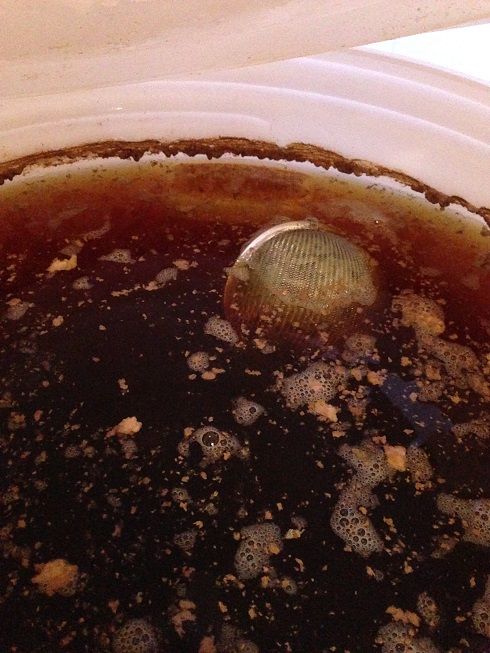

The infusing ball with the more compacted hops sank straight away with the looser goldings just hanging on to the surface:

-
BrewerBen
Re: AG #45 1890 Whitbread X Ale
This beer is alarmingly drinkable at 6.1%. It has quite a sweet aroma with a dry taste and bitter after taste although i can't spot any real character from the hops. It doesn't taste as strong as it is. Not quite the beer i was expecting but its still a good pint. Now i'm starting with water treatment i may brew this one again for comparison as this was brewed with water with a alkalinity of 256 mg/l and as its a pale ale it may end up a completely different beer withe the alkalinity reduced. I would also probably use a less attenuating yeast to try and keep the gravity a bit higher.
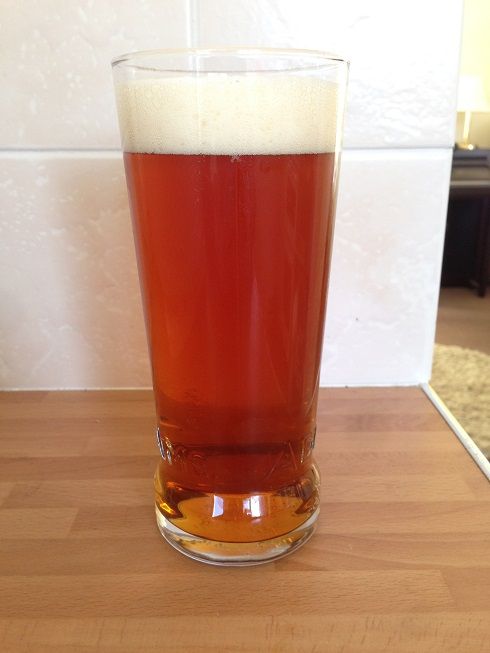

-
JKaranka
Re: AG #45 1890 Whitbread X Ale
What water treatment would you use? I have really bland, soft water in South Wales. I'm adding some gypsum for sulphur (5-10 grams) for stouts and porters. For something that pale I'd probably add the gypsum plus 2g of lactic acid to compensate.
-
Padalac
Re: AG #45 1890 Whitbread X Ale
Really interesting! Is there any beer you have tried that you would compare it to?
-
BrewerBen
Re: AG #45 1890 Whitbread X Ale
I'm mainly reducing the alkalinity with CRS, using the salifert test kit before and after treatment. I do intend to send a sample off for analysis so i can start a more measured approach on what other additions i should add though.
There is nothing that comes to mind when comparing it to other ales, maybe the sweet aroma has a hint of Belgian to it but nothing like as prominent. I don't drink many beers this strength to compare to though.
There is nothing that comes to mind when comparing it to other ales, maybe the sweet aroma has a hint of Belgian to it but nothing like as prominent. I don't drink many beers this strength to compare to though.

